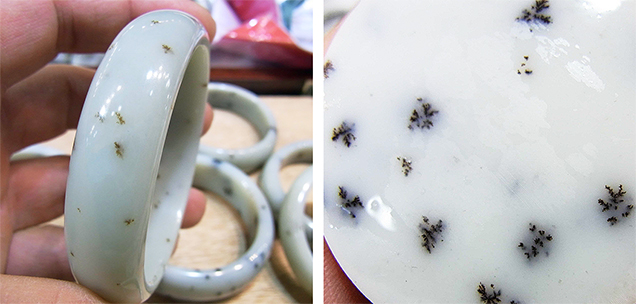Dendritic Inclusions in Nephrite from Dahua, China

Since the 2010s, with the discovery of nephrite ore deposits in Luodian County, Guizhou Province, a significant amount of nephrite has been mined in the town of Yantan in Dahua Yao Autonomous County, located in the northwest of the Guangxi Zhuang Autonomous Region (Z. Yin et al., “Nephrite jade from Guangxi Province, China,” Fall 2014 G&G, pp. 228–235). Previously we reported on the nature of the chlorite inclusions found in this nephrite, and here we identify the chlorite as penninite.
The discovery of Dahua nephrite has eased the increasingly tight nephrite supply situation in China. Owing to its large reserves, the deposit has vast potential for future development. This material is of high quality and comes in a diverse array of colors including white, gray, light green, dark green, light yellow, and black. All bodycolors have been found to contain distinctive dendritic inclusions (figure 1). Dahua nephrite is popular with consumers, thus bringing huge economic benefit to the locality.
Dahua nephrite is mainly distributed around the river near the Yantan hydropower station. The ore body occurs in the limestone formed at the Qixian stage of the Paleozoic Permian system. The magmatic rocks in the area are basic intrusive rocks, divided into diabase and gabbro. The ore bed containing the nephrite is composed of dark gray stratified limestone of low to medium thickness, interspersed with fine calcite veins (B. Wang et al., “Gemmological and mineralogical characteristics of nephrite from Guangxi,” Journal of Gems and Gemmology, Vol. 14, No. 3, 2012, pp. 6–11). The samples were tested by standard gemological methods, polarizing microscopy, environmental scanning electron microscopy (ESEM), X-ray diffraction (XRD), Raman spectroscopy, laser ablation–inductively coupled plasma–mass spectrometry (LA-ICP-MS), and energy-dispersive spectroscopy (EDS). We conducted the tests at the National Key Lab of the China University of Geosciences in Wuhan.
The refractive index of Dahua nephrites ranged from 1.60 to 1.63. The average hydrostatic specific gravity was 2.99, and the Mohs hardness was about 6.5. These properties were very similar to those of the samples previously tested, which had a spot RI of 1.61–1.62 and a hydrostatic SG of 2.88–2.90 (Yin et al., 2014).
The Raman spectra (peaks at 225, 370, 676, 1029, and 3677 cm–1), infrared spectra, and X-ray powder diffraction (characteristic lines at 3.1189, 8.3968, 3.2702, and 2.7007 Å) were consistent with tremolite, showing that the main composition mineral of Dahua nephrite is tremolite with good crystallinity. Chemical composition analysis showed that the Mg2+/(Mg2+ + Fe2+) value of nephrite samples from Dahua was 0.973, identifying the main mineral as tremolite.
The REE distribution pattern of Dahua nephrite had an average value of ∑ REE and LREE/HREE of 5.32 and 2.60, respectively, indicating that Dahua nephrite is slightly enriched in light rare earth elements. The δCe of the samples ranged from 0.21 to 0.91, with an average value of 0.47, indicating a negative Ce anomaly. This suggests that Dahua nephrite was formed in a sedimentary metamorphic environment, with high oxygen fugacity and a single source of nephrite ore-forming fluid. The average δEu value of the samples was 0.71 in the range of 0.12–2.01, indicating a negative Eu anomaly. The negative Eu anomaly in this area may be due to the separation and crystallization during the ore-forming process of nephrite.
Most nephrite in Dahua has dendritic inclusions whose colors are mainly brownish yellow, brownish green, and black distributed in the form of branches, clumps, and the like. These “variegated” inclusions were actually determined to be penninite (belongs to the chlorite group) using modern techniques including routine gemstone testing, X-ray powder diffraction, scanning electron microscope, and EDS. According to the composition determined by EDS testing, we calculated the atomicity of Si with O20 as a reference. The results were as follows: The number of Si atoms was 6.4, and Fe2+/Fe + Mg was 0.16, indicating that the chlorite inclusion was a type of penninite (red cross in figure 2, from the chlorite classification scheme in Y. Hu et al., “Related studies on characteristic altered mineral chlorite,” West-China Exploration Engineering, No. 11, 2019, pp. 132–134).

The variegated chlorite inclusions in Dahua nephrite are very useful identifying characteristics. With the exception of Luodian nephrite, which contains similar inclusions, such distinctive dendritic inclusions have yet to be discovered in white nephrite deposits; therefore, it is potentially a significant tracer for origin. The Dahua nephrite contains penninite, a type of chlorite (i.e., hydrothermally metamorphosed tremolite) (Yin et al., 2014). As an inclusion unique to Dahua nephrite, penninite serves as an important reference for origin tracing.



